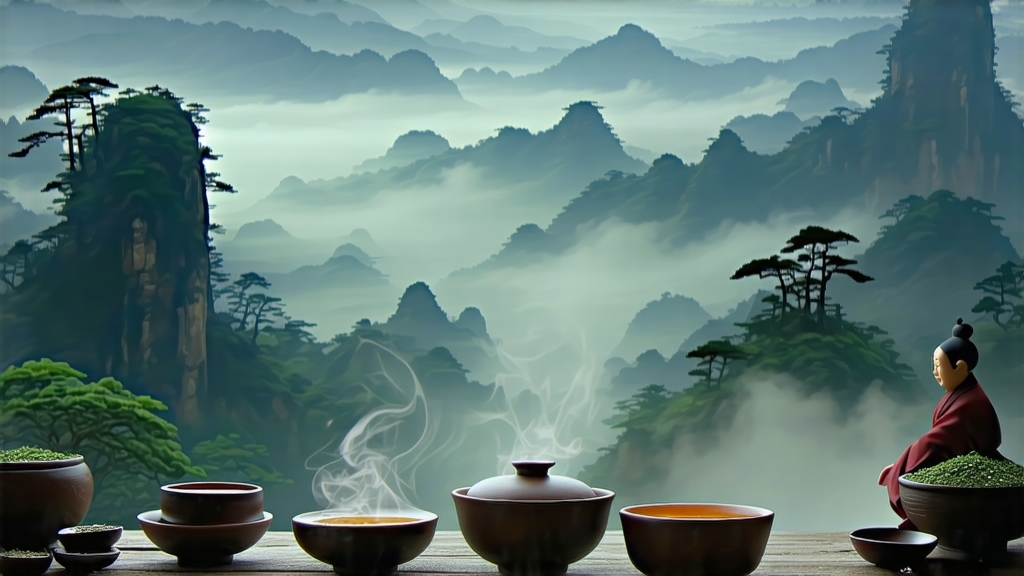
If green tea is the youthful scholar of Chinese leaf and pu-erh the bearded sage, then Tie Guan Yin is the meditative poet who walks between their worlds. Known in the West as “Iron Goddess of Mercy,” this oolong has carried the scent of orchids and the mineral breath of Fujian’s granite peaks across four centuries of maritime trade, palace tribute, and now, third-wave cafés from Brooklyn to Brisbane. To understand Tie Guan Yin is to witness how a single cultivar can embody both the engineering precision of modern tea science and the quiet devotion of village artisans who still kowtow to a 300-year-old mother tree.
Anxi County, southern Fujian, is a wrinkle of folded mountains where morning fog lingers like silk. Here, at elevations between 500 and 1,000 metres, the Red Heart Guan Yin cultivar (Tie Guan Yin ben shan zhong) sinks its roots into weathered granite soils laced with quartz. The strain is temperamental—yielding only two flushes a year, yet when coaxed by cool nights and a 1,600 mm annual rainfall, it produces leaves unusually high in floral lactones and low in bitter catechins. Geology and genetics conspire to give the tea its signature “rock rhyme” (yan yun), a lingering limestone note that separates great Tie Guan Yin from everyday oolong.
Legends date the tea to the Yongzheng era (1723–1735). A devout farmer named Wei Yin nightly lit incense to a dilapidated iron statue of Guanyin, the bodhisattva of compassion. In dream, the goddess guided him to a hidden shrub behind her temple. He transplanted it, cultivated the leaves, and found the infusion so fragrant that it cured his ailing mother. Wei named the tea after the iron icon, and Anxi farmers still leave the first pick of spring at village shrines in gratitude. Historians counter that the cultivar emerged from selective breeding of older Huang Jin Gui and Xiao Ye Wuyi strains, but in Anxi the myth is told as fact, and every May the Goddess palanquin is carried through tea terraces amid firecrackers and drifting petals.
Tie Guan Yin is not a single tea but a spectrum of styles governed by one variable: oxidation, stopped by heat at the moment the leaf’s edges turn ochre while the heart stays jade. Traditional “nong xiang” (heavy aroma) versions, still preferred in Chaozhou gongfu houses, are oxidised 40–50 %, then charcoal-baked over lychee wood for 20–30 hours in bamboo baskets. The result is a curled, jet-black pellet that smells of cacao, toasted sesame and warm orchid. In the 1990s Taiwanese vacuum technology arrived, and Anxi makers created “qing xiang” (light aroma) Tie Guan Yin: oxidation dropped to 15–20 %, baking replaced by short electric tumblers. The leaf stays emerald, the liquor neon-green, the aroma a heady snap of fresh gardenia. Between these poles lie “zhong huo” (medium fire) and the boutique “laoren tie” (elder iron) aged in earthen jars for five years until the liquor turns amber and tastes of dried longan, leather and temple incense.
Plucking begins when the leaf bud sports a small fish-tail open face, usually around Guyu (Grain Rain) in late April. Only the top three leaves are taken, carried in shallow bamboo sieves to prevent bruising. Inside the village workshop the real choreography starts: wilting under 25 °C fans for two hours to shed grassy moisture; tossing in a 1.2-metre cylindrical bamboo drum rotating at 18 rpm—this gentle battering cracks cell walls, initiating oxidation while curling the leaf. Every 15 minutes the master inserts an arm, feels for temperature and elasticity, then decides the next toss’s force. When the edges redden and the aroma shifts from cut grass to peach skin, the leaf is quickly pan-fired at 280 °C for three minutes to kill green enzymes. While still hot, it is wrapped in square canvas bundles and subjected to the “wrap-rub” cycle: 6 seconds of machine compression, 4 seconds release, repeated 60 times over an hour. This shapes the iconic dragonfly-head pellet and squeezes residual moisture to the surface, ready for a final 120 °C bake. A finished batch of 500 g requires roughly 1,600 hand-picked shoots, 18 hours of continuous labour,